Global Adhesive Films Market - Comprehensive Data-Driven Market Analysis & Strategic Outlook
The global adhesive films market by Metastat Insight will transcend its existing horizons as sectors continue to reshape the way material bonding and surface protection are handled. Adhesive films have already proved themselves to be unsung drivers of advancement in the fields of manufacturing, healthcare, packaging, and automobile. Yet this industry's future is vastly larger than its present industrial use. Besides technological progress, the future will also witness these films being fundamentally changed in terms of how they interact with other materials, as they adapt to new-age requirements that mainly focus on energy-saving, eco-friendliness, and design flexibility.
- The global adhesive films market valued at approximately USD 13 Billion in 2025, growing at a CAGR of around 9.4% through 2032, with potential to exceed USD 24.4 Billion.
- Acrylic-Based Films account for nearly 44.2% market revenues, driving innovation and expanding applications through intense research.
- Key trends driving growth: Rising demand in electronics and automotive industries for lightweight bonding solutions., Growing use in flexible packaging and label applications.
- Opportunities include Development of eco-friendly and recyclable adhesive films for sustainable applications.
- Key insight: The market is set to grow exponentially in value over the next decade, highlighting significant growth opportunities.
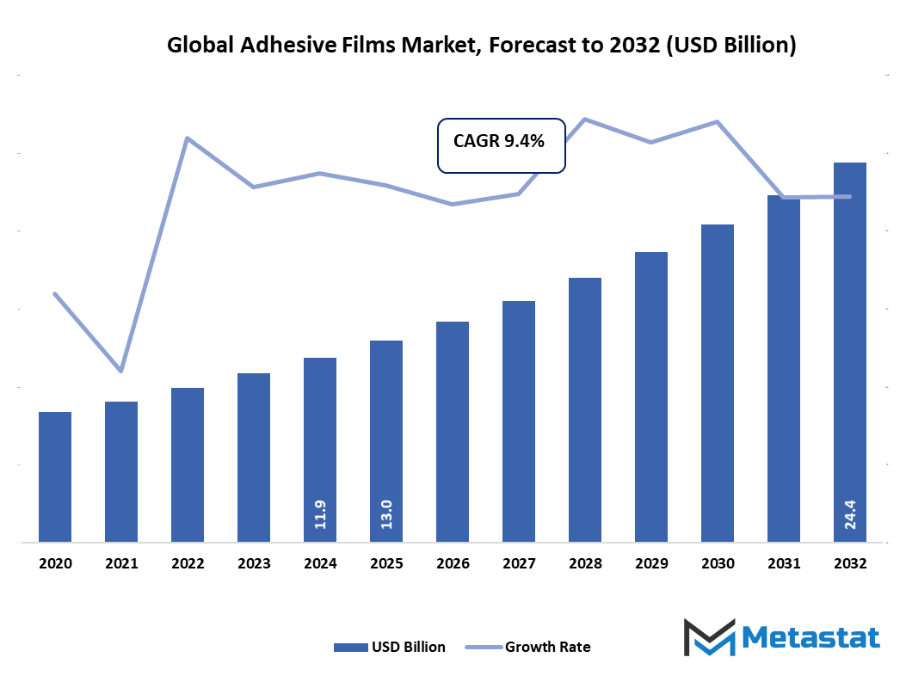
In what way will the increased move toward green materials change the global adhesive films market to be environmentally-friendly? Might fast technological innovations shake up the usual manufacturing processes and set new product performance standards? And as sectors require more sustainability and efficiency, are the existing market players capable of matching the pace of changing customer needs and getting pressure from regulations?
With manufacturing settings gradually becoming more advanced and automated, adhesive films will be able to improve further, becoming more intelligent, and more aware of the materials to which they are attached. The market will witness the development of multifunctional films that do more than adhere providing insulation, resistance, or even active sensing capabilities built into stratified configurations. That expansion will address not only product quality but also how films fit into greater systems of manufacturing and product lifecycles.
Market Segmentation Analysis
The global adhesive films market is mainly classified based on Adhesive Type, Backing Material, Technology, End-Use Application.
By Adhesive Type is further segmented into:
- Acrylic-Based Films
The global adhesive films market will see robust uptake of acrylic-based films owing to their stronger bonding property and thermal resistance. The films will be crucial in high-performance industrial applications, where durability and long-term adhesion will be critical. Their resilience in harsh conditions will make them a prized asset in several manufacturing industries.
- Rubber-Based Films
Rubber-based films in the market will find increased traction for short-term applications requiring flexibility and removability. Their cost-in-effectiveness as well as high tack properties will render them a convenient option for packaging and labeling. The market will continue to advance these films for increased versatility and user ease.
- Silicone-Based Films
Silicone-type films will define the market through their increasing application in electronics and medicine. These films will be preferred because of their exceptional chemical resistance and endurance of harsh temperatures. Development in the future will make them more precise to deliver top-class performance in harsh industrial environments.
- Other Adhesive Films
Other adhesives films, such as hybrid and custom types, will be among major players in the global adhesive films market. Development will concentrate on creating environmentally friendly and high-strength products. Demand for specialty products will propel research into films intended for niche and sustainable applications.
By Backing Material, the market is divided into:
- Polyester Films
Polyester films will remain the preferred choice in the global adhesive films market as a result of their superior dimensional stability and transparency. The films will be used in the packaging, electronics, and automotive sectors, providing consistent performance and enduring adhesion. The increasing focus on recyclable materials will also increase their use.
- Polyethylene Films
In the market, polyethylene films will be prized for their flexibility and water resistance. They will continue to be necessary in applications where durability and lightness are needed. Emerging innovations will make them more sustainable in their profile, thus complying better with environmentally friendly production practices.
- Polypropylene Films
Polypropylene films will continue to have a stable market share in the market due to their strength versus transparency versus chemical resistance. These films will gain additional uses in labeling and protection film segments. Producers will invest in updated manufacturing technologies to enhance their adaptability and eco-friendliness.
- Paper-Backed Films
Paper-backed films will continue to drive the global adhesive films market with their applications in packaging and protection of surfaces. Their biodegradable nature will fit in with the increasing trend for sustainability. Development will focus on increasing their strength without compromising on the composition being environmentally friendly.
By Technology the market is further divided into:
- Solvent-Based Adhesives
Solvent-based adhesives will still have a place in the global adhesive films market for applications demanding high bond strength and resistance to extreme conditions. The adhesives will be used for industrial applications where performance cannot be compromised. Future research will probably focus on lower-emission versions to satisfy global environmental regulations.
- Water-Based Adhesives
Water-based adhesives will find substantial footing in the market because of their environmental friendliness and easy application. They will find extensive use in labeling and packaging due to their cost-effectiveness and safety. With ongoing innovations, they will be made stronger and more versatile for different applications.
- Hot-Melt Adhesives
Hot-melt adhesives will see an increase in adoption in the global adhesive films market due to their rapid-setting technology and neat application. These adhesives will aid those industries that demand streamlined production processes. Technological advancements will improve their heat resistance and bonding flexibility in upcoming manufacturing.
By End-Use Application the global adhesive films market is divided as:
- Packaging
The packaging segment will lead the global adhesive films market with support from food, beverage, and consumer goods industries. Sealing, labeling, and protection will be critical applications of adhesive films. The future will be about improved films with recyclability and better performance without sacrificing strength or clarity.
- Electronics
Electronics will be a central component of the market because films will provide insulation, bonding of components, and protection. Lightweight and miniaturized devices will be serviced by precision adhesives. Developments will center around heat resistance and conductivity in order to address increasing demands of smart technologies.
- Automotive
The automotive sector will keep on using adhesive films from the market for lightweight assembly and interior uses. These films will substitute conventional fastening techniques, enhancing efficiency and design versatility. The emphasis will be on materials that offer increased durability and fuel economy.
- Construction
In the construction industry, the market will experience increasing demand for long-lasting bonding solutions applied to insulation, floors, and surface finishing. Adhesive films will optimize project efficiency by providing clean, long-duration adhesion. New technologies in the future will provide enhanced resistance to weathering and structural load.
- Medical & Healthcare
Medical and healthcare industries will rely more on the market adhesive films for device assembly and wound care. The films will assist with safety and cleanliness standards. Biocompatibility and skin-friendly material advancements in the future will prioritize patient comfort and protection.
- Other
The uses of the global adhesive films market will be aerospace, signage, and industrial assembly. These films will provide reliability and accuracy across specialized industries. Future will emphasize developing multifunctional films that provide strength, flexibility, and sustainability in harsh conditions.
|
Forecast Period |
2025-2032 |
|
Market Size in 2025 |
$13 Billion |
|
Market Size by 2032 |
$24.4 Billion |
|
Growth Rate from 2025 to 2032 |
9.4% |
|
Base Year |
2024 |
|
Regions Covered |
North America, Europe, Asia-Pacific, South America, Middle East & Africa |
Geographic Dynamics
Based on geography, the global adhesive films market is divided into North America, Europe, Asia-Pacific, South America, and Middle East & Africa. North America is further divided in the U.S., Canada, and Mexico, whereas Europe consists of the UK, Germany, France, Italy, and Rest of Europe. Asia-Pacific is segmented into India, China, Japan, South Korea, and Rest of Asia-Pacific. The South America region includes Brazil, Argentina, and the Rest of South America, while the Middle East & Africa is categorized into GCC Countries, Egypt, South Africa, and Rest of Middle East & Africa.
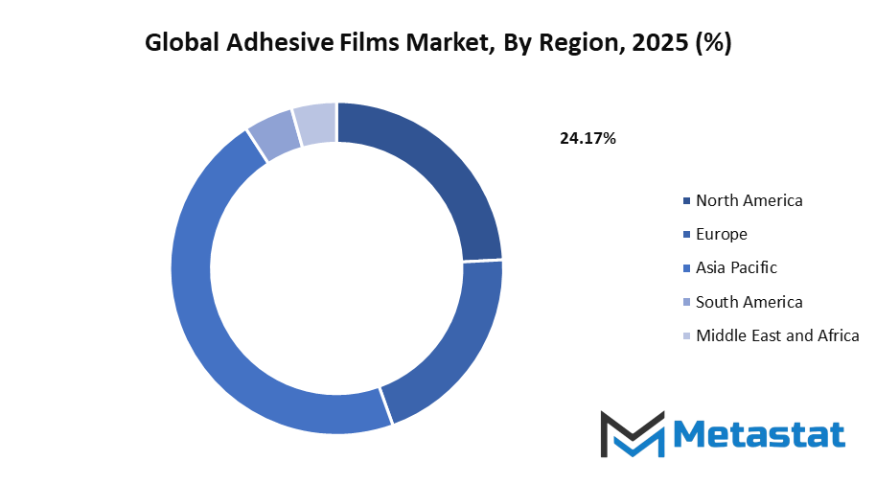
Competitive Landscape & Strategic Insights
The global adhesive films market report by Metastat Insight boasts a powerful combination of global majors and emerging regional players, who continue to drive the direction of the industry. Adhesive films have turned to be one of the necessary parts of the several industries like automotive, packaging, electronics, and construction, since they provide bonding solutions that are not only reliable, but also increase the performance and design flexibility. As industries are moving towards materials that are cost-effective and light-weight, the market for adhesive films will be growing continuously and thus, it will be the main driver of product design and manufacturing quality worldwide.
The leading companies such as 3M Company, Avery Dennison Corporation, Henkel AG and Co. KGaA, and H.B. Fuller Co. are dominating the biggest shares of the market due to their advanced technologies and vast product portfolios. These enterprises have made their mark with innovation, supplying films that meet specific industrial standards such as thermal stability, long life, and eco-friendliness. At the same time, the major players like Arkema SA, Ashland Inc., and Nitto Denko Corporation are widening their scope by introducing the products that are targeted at the application of the next generation which will allow the industries to reduce their environmental footprint while increasing the efficiency.
Regional and emerging competitors like GRANITOL, Pontacol AG, and Specialty Adhesive Film Co. Inc. are playing their part in stimulating the market growth by fulfilling local needs and offering affordable solutions. With their presence, there is an added element of competition that pushes innovation and accessibility further across markets. It is an undisputed fact that the combination of worldwide knowledge and local flexibility is a sure way that adhesive films will be the key to industrial processes improvement and product quality enhancement.
Companies like Saint-Gobain Performance Plastics, Toray TCAC Holding B.V., and UPM Kymmene Corp. are going to be the first to produce eco-friendly adhesive films in line with the environment sustainability trend. These changes will be a determining factor in setting the future market directions as industries are going to be more and more committed to eco-friendly manufacturing. Besides that, the innovations from the company Hitachi Chemical Company Ltd., Lintec Corporation, and Rogers Corp. will be there forever to upgrade the film to have better adhesion, flexibility, and stability in different kinds of use.
The global adhesive films market is destined to keep on evolving with the technology and sustainability spirit as the main source of the innovation. The competition landscape with the current players and the new entrants is a guarantee for the industry to be a lively one and to move forward. By putting more focus on the quality, efficiency, and environmental aspects, the use of adhesive films will be an important factor in the future of several industries worldwide.
Market Risks & Opportunities
Restraints & Challenges
High price tag of premium adhesive films in comparison to standard adhesives
The global adhesive films market is going to see a challenge in maintaining the expensive nature of the premium formulations. Being made from specialized raw material and manufacturing technologies, premium adhesives are inherently more expensive than the conventional ones. As a consequence, such a premium price could restrain the broad-based adoption of the product, in particular, by small and medium-scale industries which are looking for cheap alternatives.
Limited thermal and chemical resistance in some applications
The global adhesive films market is going to be limited due to the thermal and chemical resistance of the adhesives in specific industrial applications. The adhesive bond exposed to high temperature or to aggressive solvents can be weakened, hence the reliability in the aerospace and automotive industry which are the most affected will decrease. The limitation will keep the manufacturers innovating and improving the products' durability so that they can be used in more areas.
Opportunities:
Eco-friendly and recyclable adhesive film development for sustainable uses
The market is going to have an excellent opportunity through the development of environmentally friendly and recyclable adhesive films. As industries become more eco-conscious, companies will be eager to invest in bio-based and recyclable adhesives as a way to save the environment. Although the move will be mostly for regulatory reasons, it will also become a selling point to environmentally friendly consumers and businesses who are looking for sustainable bond solutions.
Forecast & Future Outlook
- Short-Term (1–2 Years): Recovery from COVID-19 disruptions with renewed testing demand as healthcare providers emphasize metabolic risk monitoring.
- Mid-Term (3–5 Years): Greater automation and multiplex assay adoption improve throughput and cost efficiency, increasing clinical adoption.
- Long-Term (6–10 Years): Potential integration into routine metabolic screening programs globally, supported by replacement of conventional tests with advanced biomarker panels.
Market size is forecast to rise from USD 13 Billion in 2025 to over USD 24.4 Billion by 2032. Adhesive Films will maintain dominance but face growing competition from emerging formats.
What will really distinguish the market is its responsiveness to next-generation sustainability and performance expectations. The dialogue will shift from what adhesive films can do to how they can help industries minimize waste, increase durability, and make production easier. Cutting-edge technologies like nanocoatings and bio-polymers will most probably drive this change, enabling adhesive films to facilitate greener manufacturing objectives without diminishing precision or strength. Outside the terms of conventional application, the direction of the market will determine the extent to which industries stick both physically and philosophically to a cleaner, smarter, and more responsive material future.
Report Coverage
This research report categorizes the global adhesive films market based on various segments and regions, forecasts revenue growth, and analyzes trends in each submarket. The report analyses the key growth drivers, opportunities, and challenges influencing the global adhesive films market. Recent market developments and competitive strategies such as expansion, type launch, development, partnership, merger, and acquisition have been included to draw the competitive landscape in the market. The report strategically identifies and profiles the key market players and analyses their core competencies in each sub-segment of the global adhesive films market.
Adhesive Films Market Key Segments:
By Adhesive Type
- Acrylic-Based Films
- Rubber-Based Films
- Silicone-Based Films
- Other Adhesive Films
By Backing Material
- Polyester Films
- Polyethylene Films
- Polypropylene Films
- Paper-Backed Films
By Technology
- Solvent-Based Adhesives
- Water-Based Adhesives
- Hot-Melt Adhesives
By End-Use Application
- Packaging
- Electronics
- Automotive
- Construction
- Medical & Healthcare
- Other Applications
Key Global Adhesive Films Industry Players
- 3M Company
- Adhesive Films Inc.
- ADHETEC
- Arkema SA
- Ashland Inc.
- Avery Dennison Corporation
- Coveris Management GmbH
- GRANITOL
- H.B. Fuller Co.
- Henkel AG and Co. KGaA
- Hexcel Corp.
- Hitachi Chemical Company Ltd.
- Lintec Corporation
- Master Bond Inc.
- Mondi Plc
- Nitto Denko Corporation
- Pontacol AG
- Resonac Holdings Corp.
- Rogers Corp.
- Saint-Gobain Performance Plastics
- Scapa Group
- Specialty Adhesive Film Co. Inc.
- Tesa SE
- Toray TCAC Holding B.V.
- UPM Kymmene Corp.
WHAT REPORT PROVIDES
- Full in-depth analysis of the parent Industry
- Important changes in market and its dynamics
- Segmentation details of the market
- Former, on-going, and projected market analysis in terms of volume and value
- Assessment of niche industry developments
- Market share analysis
- Key strategies of major players
- Emerging segments and regional growth potential



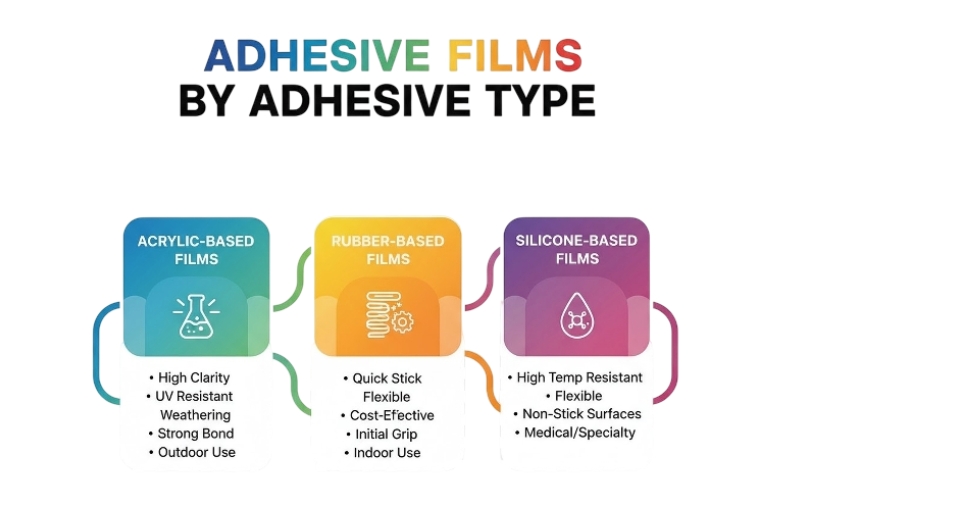
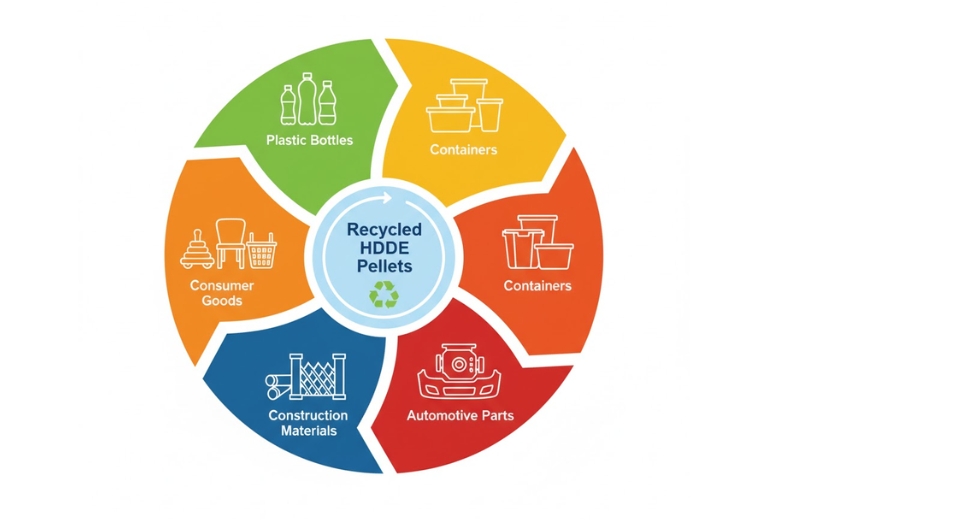
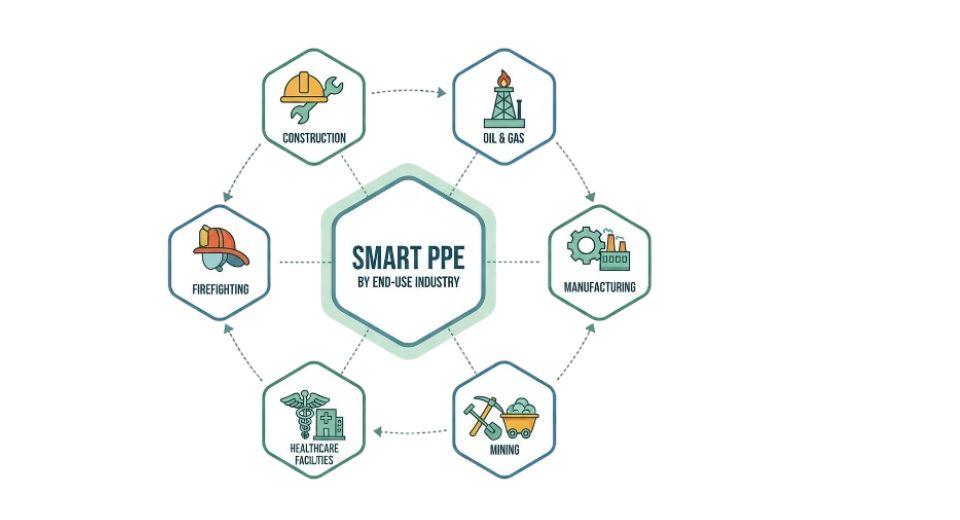
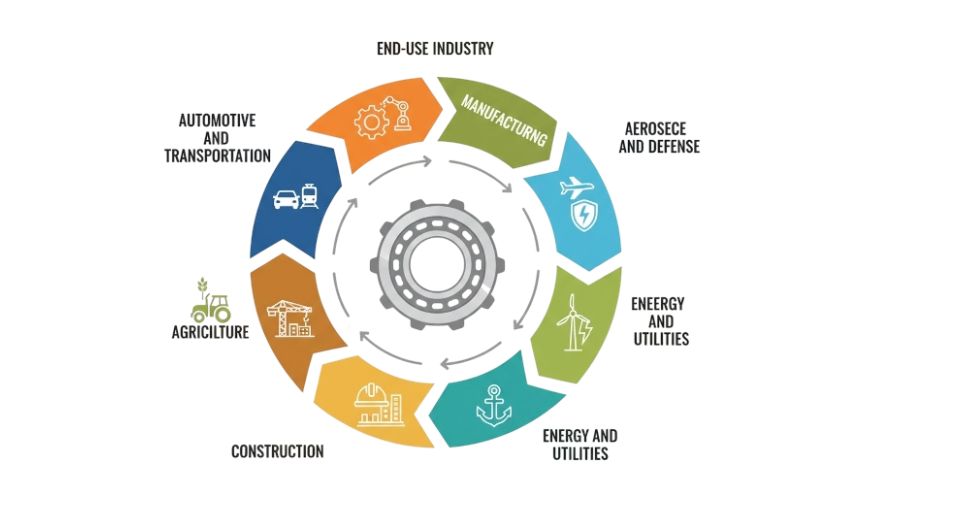

 US: +1 3023308252
US: +1 3023308252






